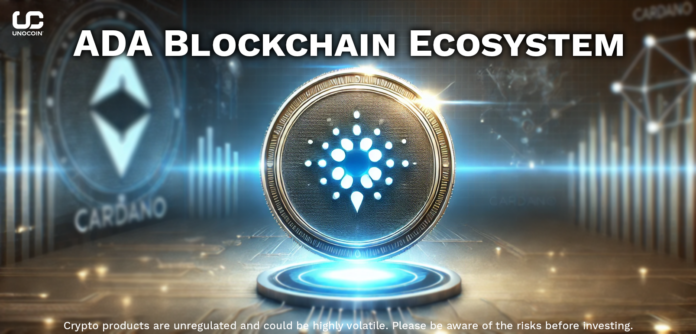Cardano is a third-generation blockchain platform known for its emphasis on scalability, security, and sustainability. Launched in 2017 by Input Output Hong Kong (IOHK), it aims to create a robust infrastructure for decentralized applications (dApps) and transactions, distinguishing itself from other blockchain platforms through a scientific approach to development. Cardano has become an important player in the blockchain ecosystem by addressing key challenges like scalability, interoperability, and governance. In this blog, we will explore the role of Cardano within the blockchain ecosystem, its unique features, and its impact on decentralized finance (DeFi) and other blockchain applications.
1. Cardano’s Place in the Blockchain Ecosystem
Cardano was designed to improve upon the limitations of first- and second-generation blockchain platforms like Bitcoin and Ethereum. It was developed using peer-reviewed research and aims to provide a more secure and efficient blockchain platform. Cardano uses a proof-of-stake (PoS) consensus mechanism known as Ouroboros, which offers more energy-efficient transaction validation than the proof-of-work (PoW) mechanisms used by networks like Bitcoin. The platform’s multi-layer architecture also allows for flexibility in supporting dApps and smart contracts.
Cardano (ADA) is gaining attention for its contributions to decentralized finance (DeFi) and its unique governance model. Unlike other platforms, which rely on centralized decision-making or limited community involvement, Cardano includes stakeholders in the governance process. Through its Voltaire governance model, Cardano’s stakeholders can vote on protocol updates, ensuring a democratic evolution of the network.
2. Key Features and Innovations
Cardano is built on a multi-layered architecture that separates the settlement and computation layers, ensuring more efficiency and scalability. The settlement layer records transactions, while the computation layer executes smart contracts and decentralized applications. This layered structure allows developers to optimize each layer independently, making Cardano more flexible in scaling its infrastructure.
One of the standout features of Cardano is its consensus mechanism, Ouroboros, which is based on PoS. Ouroboros ensures that validators (those who hold a stake in the network) are responsible for maintaining the integrity of the blockchain. This eliminates the need for high-energy computing power, making Cardano a more sustainable blockchain.
Another essential feature is Cardano’s interoperability. Cardano’s architecture allows it to interact with different blockchains and legacy systems using the Cardano Computation Layer (CCL). This is crucial for creating a more interconnected and accessible blockchain ecosystem, where different networks can communicate and operate together seamlessly.
3. Cardano’s Approach to Scalability and Interoperability
Scalability and interoperability are two significant challenges facing blockchain technology. As blockchain networks grow, they often face congestion and slower transaction times. Cardano addresses these issues through its multi-layer architecture and innovative scalability solutions.
Cardano employs a sharding solution called Hydra, which allows the network to process thousands of transactions per second (TPS). Hydra works by creating mini-blockchains (or heads) that can process transactions in parallel, drastically increasing the network’s capacity without sacrificing security or decentralization. This makes Cardano one of the most scalable PoS platforms in the blockchain industry.
Regarding interoperability, Cardano’s design allows it to communicate with other blockchains and traditional financial systems. This is made possible through the CCL, which facilitates cross-chain communication and interaction. Cardano’s focus on interoperability is a major differentiator, as many other blockchains operate in isolation, limiting their utility in a broader ecosystem.
4. Smart Contracts and dApps on Cardano
Cardano’s smart contract functionality is powered by Plutus, a unique programming language developed for the platform. Plutus enables developers to create robust and secure smart contracts, essential for various industries such as finance, healthcare, and supply chain management. The secure nature of Plutus smart contracts ensures that they are resistant to common security vulnerabilities, making them a reliable option for businesses and developers.
Cardano’s approach to smart contracts is critical in supporting decentralized applications (dApps). With the growing demand for dApps, Cardano offers developers a scalable and secure platform to build applications that can handle a large volume of transactions without compromising speed or security.
5. Cardano’s Role in the Development of DeFi
Decentralized Finance (DeFi) is a rapidly growing sector within the blockchain industry, and Cardano has positioned itself as a key player in this space. DeFi applications aim to provide financial services, such as lending, borrowing, and trading, without the need for intermediaries like banks. Cardano’s secure, scalable, and energy-efficient platform makes it an ideal environment for building DeFi protocols.
The platform’s native token, ADA, is integral to many DeFi protocols on the Cardano network. ADA is used for staking, governance, and various DeFi activities such as lending and trading. As Cardano continues to develop its ecosystem, more DeFi projects are expected to be built on the platform, further cementing its role in the decentralized finance space.
6. Cardano’s Impact on the Wider Blockchain Ecosystem
Cardano’s impact on the broader blockchain ecosystem is significant. As a third-generation blockchain platform, it has addressed many of the shortcomings of earlier blockchain models. Cardano’s use of PoS not only improves energy efficiency but also enhances security and decentralization. Its innovative solutions for scalability and interoperability have influenced other blockchain platforms, pushing the industry toward more sustainable and scalable models.
By solving problems related to transaction speed, energy consumption, and cross-chain communication, Cardano is helping to drive the next phase of blockchain adoption. The platform’s contributions to DeFi and its growing community of developers and stakeholders make it a crucial player in the blockchain ecosystem.
Conclusion: The Future of Cardano in the Blockchain Ecosystem
Cardano’s future looks promising as it continues to innovate in areas like scalability, interoperability, and DeFi. Its unique approach to governance, sustainability, and security makes it a platform well-suited for long-term growth and adoption. As the blockchain ecosystem evolves, Cardano’s role will likely expand, making it a cornerstone in the development of decentralized applications and financial systems.
Please find the list of authentic Unocoin accounts for all your queries below:
- Twitter: https://twitter.com/Unocoin
- Instagram: https://www.instagram.com/unocoin/
- Facebook: https://www.facebook.com/unocoin/
- LinkedIn: https://in.linkedin.com/company/unocoin
- YouTube Channel: https://www.youtube.com/c/Unocoin/videos
- Newsletter: https://medium.com/subscribe/@Unocoin_growth
- Blogs: https://blog.unocoin.com
- Telegram Group: https://t.me/Unocoin_Group
- Telegram Channel: https://t.me/+fasQhTKBsfA5N2Zl
- Telegram: https://t.me/UnocoinSupport_Bot
- E-mail id: [email protected]
- Contact details: 7788978910 (09:30 AM IST – 06:30 PM, Mon-Sat)
- App store link: https://apps.apple.com/us/app/unocoin/id1030422972?ls=1
- Playstore link: https://play.google.com/store/apps/details?id=com.unocoin.unocoinwallet
Disclaimer: Crypto products are unregulated as of this date in India. They could be highly volatile. At Unocoin, we understand that there is a need to protect consumer interests as this form of trading and investment has risks that consumers may not be aware of. To ensure that consumers who deal in crypto products are not misled, they are advised to DYOR (Do Your Own Research).




